I If you think of soil health, the best place to start is with ecosystem engineers – earthworms. The results from the spring pilot farmland earthworm survey indicated that turning over a spadeful of soil in any field, and you are highly likely to find at least one earthworm.
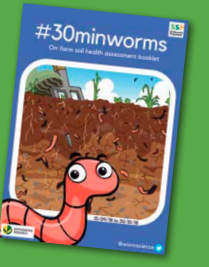
There are 3 types of worms that make up the earthworm community in farmland soils, the first type are the small (often matchstick sized) red worms ‘surface’ worms that live in the surface of the soil, feeding on surface litter or organic amendments like muck, and are a good source of prey for native wildlife.
The second type are the pale worms that live in the topsoil – ‘ topsoil’ worms, horizontally burrowers that mix and aggregate the soil together, mobilising nutrients for plant uptake. The third group are the large drainage worms or ‘deep burrowing’ type, distinctive by being pigmented and often the size of a pencil, which make deep (up to 2m) vertical burrows, supporting deep crop rooting and water infiltration.

The surface worms and drainage worms are vulnerable to soil management, becoming rare or even locally extinct in over-worked farmland soils. The Spring survey indicated that 48 % of fields had no sightings of at least one of these earthworm types – with implications to soil structure and wider ecosystem services. If there is no evidence for basic earthworm biodiversity infield, this is an early warning sign of potential over-cultivation (intense, frequent tillage) or under-fed (no organic matter return) soils, that may benefit from a change in soil management practices (for example, reducing tillage intensity, cover cropping or application of organic matter).
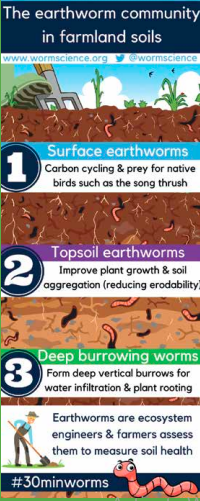
The pilot worm survey went well (>1300 ha was surveyed by farmers around the country) with farmers recording the quality (types of worms present) and quantity (counting the total number of worms present) of earthworms in their fields. In terms of quantity, the average was 9 worms per 20cm3 soil pit, high numbers of worms (>16 worms per pit) were rare although the top fields could support 27 worms per soil pit.
The feedback from the participants was to shorten the protocol to enable more within and between field comparisons, and the data analysis and statistics indicated this was robust – leading to the new #30minworms survey, which involves digging 5 soil pits across the field. Participants also wanted more support in earthworm identification, so the new survey booklet provides more detailed pictures, and there are online resources including an earthworm identification tutorial quiz and YouTube demonstration.
When to sample? Autumn or Spring are the best times for earthworm assessments, the #30minworms survey will run between the 15th September to the 30th October, with full details, method support and the survey booklet available at www.wormscience.org.
#30M WORMS METHOD
Equipment
• Spade & ruler
• Mat
• Pot for worms
• Bottle water
• Booklet & pen
Procedure
5 soil pits per field using standard W shape field sampling
1. Dig out a 20 cm x 20 cm x 20 cm soil pit and place soil on mat (30 sec)
2. Hand-sort soil (5-minutes), placing each whole earthworm into the pot. Note if pencil size vertical burrows are present and tick/cross on the results sheet
3. Count the total number (adults and juveniles) of earthworms and write down
4. Separate earthworms into adults (only a few) and return juveniles to soil pit. May need to rinse worms with water to detect if a saddle is present
5. Count the numbers of each type of adult earthworm (key shown) and write down.
6. Return worms to soil pit and back fill with soil
7. Check the soil surface for the presence of middens (key shown)
8. Repeat steps 1 – 7, until 5 soil pits per field have been assessed
9. Please input your data at www. wormscience.org for results analysis
ID Step 1 of 2:
Separate Adult vs Juveniles Only adults have a saddle or belt (worm at top of each picture)

ID Step 2 of 2:
Practice your ID skills on the worm ID quiz at www.wormscience.org
Type 1: Surface worms e.g. Lumbricus castaneus, Lumbricus rubellus Small (matchstick) size <8 cm when not moving Red bodied worm. They breakdown surface litter and good food source for native birds.
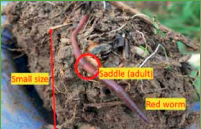
Type 2: Topsoil worms e.g. Aporrectodea caliginosa, Allolobophora chlorotica Small – Medium size Pale worms: grey, pink or dark green colour. They mix soil & mobilise nutrients for plant uptake, supporting crop productivity.
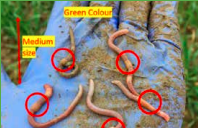
Type 3: Deep burrowers e.g. Lumbricus terrestris, Aporrectodea longa Large (pencil) size Heavily pigmented (red or black headed earthworms). They are the ‘drainage’ worms – can form 2m vertical burrows, helping with water infiltration and deep plant rooting.
Deep burrowing earthworm presence
Deep burrowers may not be captured in the topsoil so look out for these indicators of their presence and note down on the data table:
1. Pencil size vertical burrow
2. Surface permanent burrows
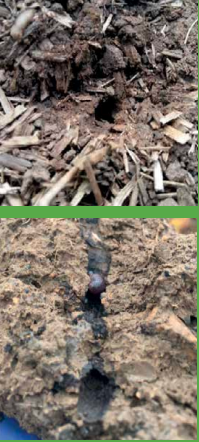
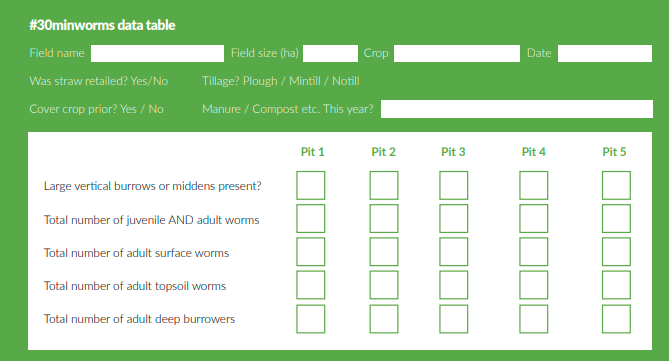
60M WORMS OUTCOME
FROM THE SPRING 2018 EARTHWORM SURVEY
Written by Jackie Stroud, Rothamsted
Earthworms are primary candidates for national soil health monitoring as they are ecosystem engineers that benefit both food production and ecosystem services associated with soil security. Supporting farmers to monitor soil health could help to achieve the policy aspiration of sustainable soils by 2030 in England; however, little is known about how to overcome participation barriers, appropriate methodologies (practical, cost-effective, usefulness) or training needs. This paper presents the results from a pilot #60minworms study which mobilised farmers to assess over >1300 ha farmland soils in spring 2018.
The results interpretation framework is based on the presence of earthworms from each of the three ecological groups at each observation (20cm3 pit) and spatially across a field (10 soil pits). Results showed that most fields have basic earthworm biodiversity, but 42 % fields may be at risk of over-cultivation as indicated by absence/rarity of epigeic and/or anecic earthworms; and earthworm counting is not a reliable indicator of earthworm biodiversity. Tillage had a negative impact (p < 0.05) on earthworm populations and organic matter management did not mitigate tillage impacts. In terms of farmer participation, Twitter and Farmers Weekly magazine were highly effective channels for recruitment.
Direct feedback from participants included excellent scores in trust, value and satisfaction of the protocol (e.g. 100 % would do the test again) and 57 % would use their worm survey results to change their soil management practices. A key training need in terms of earthworm identification skills was reported. The trade-off between data quality, participation rates and fieldwork costs suggests there is potential to streamline the protocol further to #30minuteworms (5 pits), incurring farmer fieldwork costs of approximately £1.48 ha-1. At national scales, £14 million pounds across 4.7 M ha-1 in fieldwork costs per survey could be saved by farmer participation.